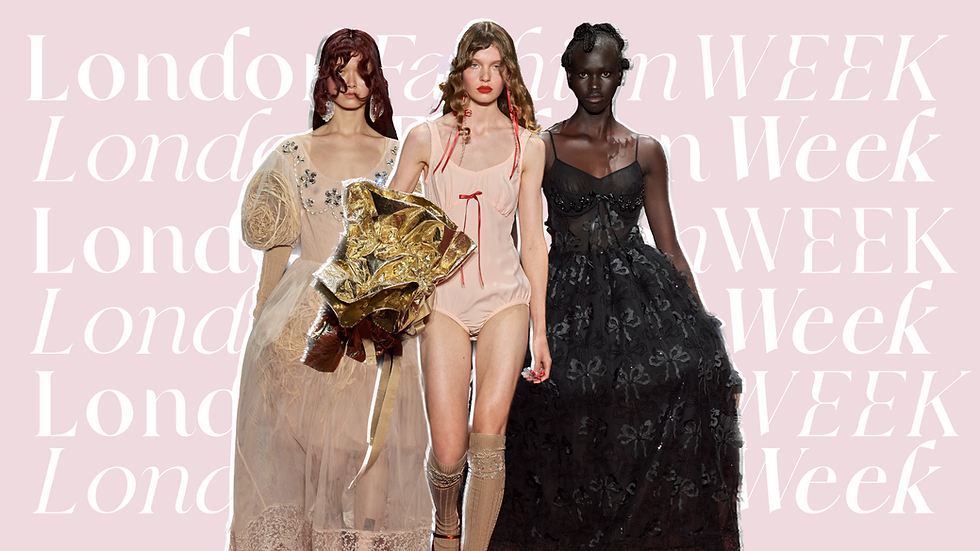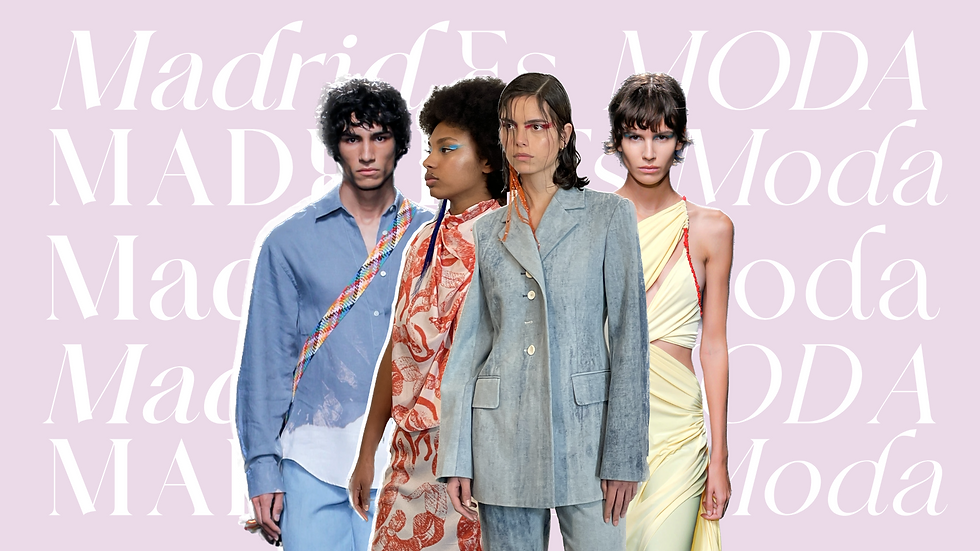From the catwalk to our wardrobes: how high fashion makes its way into our daily life
- Valentina Danaus
- 30 nov 2022
- 7 Min. de lectura

Text by Valentina Danaus, February the 7th of 2020
Making a fashion statement is unavoidable. From TV, billboards and Instagram feeds to street style and work attire, the fashion industry has an unconventionally impactful place in our daily life. Clothing is a tool of communication, a sign of status, and transmitter of social and cultural codes, an area in which even the lack of intention is a declaration on its own.
Fashion also constitutes one of the most successful and rare industries to rise in the past decade with a 5.5 percent annual growth. An industry that not only moves billions of dollars, but also millions of people to the main fashion capitals of the world.
The High-Fashion model
The world of high fashion tends to be regarded as a somewhat untouchable force, with its value relying on its exclusivity and unattainability. Opposite to the regular business model, the world of luxury in which high fashion operates is distinctively cold and alien for the regular citizen.
However, as unreachable and mutable as the industry is, it also has a unifying factor. From the exclusive attendees of the fashion shows to the day-to-day consumers at the shop, our stylistic choices are determined by a limited set of options that reflect society in the same measure that it helps to shape it in the process. But how does such an exclusive industry gets filtered into our daily lives?
The process used to start in the catwalks. Fashion shows as we know them had their start at a much more humble setting back to Paris in the 1860s with Charles Frederick Worth´s collection showings using real models instead of mannequins, and have grown to become highly successful and bombastic economical and cultural phenomenons —like the Yves Saint Laurent televised stadium show that served as an opening to the soccer World Cup final in 1988.
With time, fashion shows have transformed themselves into a theatrical and revolutionary business model, so successful that it has been imitated outside of the fashion borders. A history that leads all the way to the present day with the reinvention of the figure of the model and the blurring line between high fashion and the high street.

The rise of the High-Street
In the past, the content of fashion shows was strictly limited to attendees of the show, no photography allowed except for the official footage that would be later sold on the black market for up to $100 a roll.
While the physical presence remains just as exclusive the images from the show are now available for anyone in less than 24 hours and rapidly acquired by designers from high street brands—first in line to take inspiration and translate it to its collections.
10 to 12 weeks later, the stores of brands like Zara and H&M are filled with pieces that look suspiciously alike, and so we get the designer look for a fraction of the price.
In high fashion, the value of the clothing isn’t exactly the sum of its design and production elements, but the illusion of unattainability, the harder it is to get, the more its desired. Get a couple of high-street brands to offer it to the masses and this added value is completely gone with the wind. But how do high-street brands get away with these dupes?
As Lawyer Biana Borukhovich explains, “In the U.S, fashion design has no copyright“
Clothing and accessories are considered “useful items” since we used them to cover our bodies. This way, as long as there isn’t any recognizable logo, name or print, fast fashion brands like Fashion Nova or Nasty Gal can copy a design to be almost identical without any repercussion.
Generally the high-street goes for a less obvious approach because plain copy while legal tends to be perceived as unattractive, so giants like Zara and Topshop opt for a mix of elements that are reminiscent enough of the designer look but not too much so that it looks like a fake item.
One example in which the “inspiration” played against a high-street brand is the case of Nasty Gal that made such an identical copy of a Balmain jumpsuit that they got it mixed up with the original.
On an Instagram post the brand claimed that Taylor Swift was wearing their design, only to discover the pop-star was —as expected —wearing the $1,825 Balmain and not the $78 Nasty Gal copy.
This problem has not been overlooked by the industry, designer Tom Ford is famous for his sporadic secret shows to make sure his designs are not as easily reproduced.
On the other hand, many designers have opted for a more compromising approach by launching collaborations with high-street brands to offer designer items at a more affordable price, preventing the dupes and making both brands more desirable in the process. Take the case of the highly acclaimed Giambattista Valli X H&M that was launched last October.
Outside of the US, there’s been more severe cases, like in 2006 when the French Maison Chloe accused Topshop of ripping off a yellow mini-dress that retails for $185 and was being sold by Topshop at $35. While the brand never admitted the copy, they ended up paying $12,000 in reparations.
Designer competitiveness aside, this sparks an interesting conversation about why fashion has such a controversial role in our society, being an industry that’s always involved in conversations about inclusivity and diversity, usually for the worst.
Not only is fashion not adaptable to the consumer, but it´s also a filtering mechanism that profits of the desires of people to look a certain way.
But it isn’t even much easier for the people who do fit the mold. The recent fall of the Victorias Secret Fashion show has sparked the debate about the impersonal treatment of models and the stereotype of the stoic distant muse that serves a lot more like a mannequin.

Spanish-Moldovian model Ioana Drobota Molina shares a similar view recalling the experience of modeling on the catwalk for several brands during the Madrid Fashion Week, stating that: “being involved in a show as a model can feel extremely impersonal (…). You think you’ve been carefully chosen for having certain features that fit the brand or the fashion designer, but in the end, you feel invisible.” Also, she reckons model life is not all rosy.
This feeling of inadequacy, or on the opposite — empowerment that we get through clothes, has been researched for years now.
It’s a natural behavior, fashion links itself with some of our more basic needs: attention, appreciation, and inclusion. Not only from the world at large but from our close circle, from the people we care about”. Psychologist Maria Jesús Gallego Ortiz
Research done by Northwestern University in the U.S defined this effect as “enclothed cognition” stating that the combination of the personal and cultural symbolism our clothing carries has the power to alter our mood and performance in life.
Added to the Chéri me effect that clothes can have on us, we have on top of it the social and cultural reality linked to the clothes we wear. Historically, fashion has a social weight that has translated both positively and negatively in people and that is enhanced by fast fashion. While fashion has been mainly associated with women for a long time, these effects make no discrimination.

As said by psychologist Maria Jesús Gallego Ortiz: “it’s a natural behavior, fashion links itself with some of our more basic needs: attention, appreciation, and inclusion. Not only from the world at large but from our close circle, from the people we care about.”
Fashion gives us the tools to define ourselves. This operates on a spectrum beyond harmless components like trendy colors and fabrics to defining ideal facial features and canonical body types.
But fashion rules don’t only affect self-image, but also consumers’ patterns. One of the main tricks publicity uses is the natural links humans make with possessions. As Social Studies professor Deborah Lupton states: “the relationships between people, things and places are very often saturated by emotion.”
The possession or lack of a certain desired object can spark both positive and negative reactions. This raises the question: is fashion an imposition or a source of empowerment?
A world of influence
In such a globalized world, another huge component of the fashion industry is the rise of beauty influencers. A marketing technique used both by the high-street and designer brands to remain relevant in this era of fast information and fierce competition.
The influencer world is in great measure another reason why fashion seems to have such an invasive role in regular people. With the concept of the insta-model also comes the idea of instant fame, all of the distant things like designer goods suddenly seem more approachable.
Anyone can aspire to this luxury fashion world in a matter of months and therefore the rich lifestyle has become more digestible by regular people.
For years, high fashion stayed away of more mainstream ways of publicizing their clothes, intending to maintain a standard of luxury and class, but as many important fashion houses had realized in the recent years, the rise of the high street and the birth of a more eclectic style started to make the classic high fashion model obsolete and therefore it needed a revival.
Sponsoring young people to endorse their products is an extremely effective way of reviving a brand, making it appear modern and approachable for the new generations that have missed the allure of the golden years of fashion and don’t have the same amount of fascination for the powerhouses of the industry.
And not only does this bring a fresh approach to the brands. It also, amongst the chaos, benefits the rise of smaller and more independent brands, as well as the mixing of the barriers between luxury and normal goods, giving space for a more diverse and inclusive fashion environment in which brands end up forced to modernize themselves and listen to what the people want.
A good example of this is the amount of new business opportunities like the well-known The Blonde Salad, a fashion and beauty blog created by fashion entrepreneur and influencer Chiara Ferragni who transformed her small platform into a multimillion-dollar company and holds unmatchable social presence (18.7 million followers)* changing the game for good.
Another trend we´re seeing is that models have turned into influencers, one of the biggest assets for brand endorsement with figures like model Bella Hadid on top of the list.
All of these changes slowly lead the fashion world to a path in which the powerful names aren’t an undeniable authority anymore, and other voices inside of fashion get to have a say in the process.
The future is looking different for the fashion industry, and therefore the future will look different for us in our wardrobes.
Notes: This article was originally written in 2020. The current followers count of account @chiaraferragni is 28,2 millions.







Comentarios